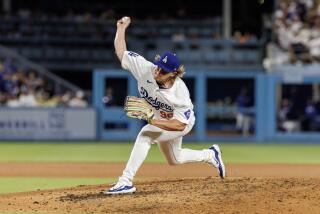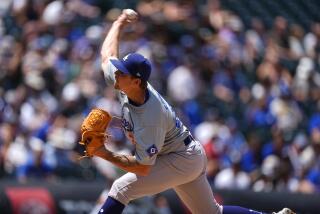The Problem With Starting at the Top
Mike Morgan and David Clyde know what Jim Abbott is going through. They, too, started at the top.
“I wanted to be the greatest pitcher who ever lived,” Clyde said. “I don’t regret anything, but things didn’t turn out the way I wanted.”
Last Saturday, Abbott became the 10th pitcher since 1965 to make his professional debut in the major leagues. The other nine all dropped down into the minors and only Burt Hooton finished his career with a winning record.
“I learned how to lose right out of high school,” said Morgan, who lost his first nine starts. “I was 18 years old and raw, and it killed me. It didn’t kill me as a person, but it killed my career.”
Clyde and Morgan, now with the Los Angeles Dodgers, at least made it back to the majors for awhile. So did Dick Ruthven, Steve Dunning, Tim Conroy and Pete Broberg.
Eddie Bane and Mike Adamson didn’t even do that.
“I wasn’t ready at all to come to the big leagues as far as pitching,” said Ruthven, who went from Fresno State to the Philadelphia Phillies in 1973.
Ruthven, now a home builder in Atlanta, was 6-9 as a rookie. He finished 123-127 in 13 seasons.
“I’m very proud that I made it, but now I think I would’ve preferred to go to the minor leagues to start. I was a thrower, and the harder I threw it, the harder they hit it,” he said. “Jim Abbott seems like he’s more of a pitcher.”
Abbott struggled in his debut Saturday night for the California Angels. He lost to Seattle, giving up three earned runs in 4 2-3 innings. He was scheduled to pitch again Thursday against Oakland.
Five position players have directly gone to the majors since 1965, the first year of the draft system. As a rule, they’ve done well with Dave Winfield, Bob Horner and Pete Incaviglia never going back to the minors.
“I don’t think I needed to go there,” Incaviglia said. “I’m doing OK with the Rangers.”
Dave Roberts, who began with San Diego in 1972, and Brian Milner, who played two games for Toronto in 1978, also began in the big leagues.
“I don’t know if going to the minor leagues for a couple of years would have made a difference,” Broberg, an attorney in Florida, said. “At the time, I wanted nothing more than to go straight from college to the big leagues. I thought I could step up, and I thought I did all right for awhile.”
Broberg left Dartmouth in 1971 and was 5-9 with a 3.46 earned run average as a rookie for Washington. He went to the minors two years later and finished in 1978 with a 41-71 record.
Dunning, a star at Stanford, won his debut with Cleveland in 1969 but wound up 4-9. His career record was 23-41.
“I don’t think it made an impact on me one way or the other,” said Dunning, a lawyer in California. “My problem was I never developed a quality breaking pitch to go with my fastball. The opportunity was there in the majors to learn it, but I never did.”
“In a sense, Jim Abbott is like I was,” he said. “He’s got a good fastball and needs to work on his breaking pitch. But there are benefits of being in the majors. You have a pitching coach, teammates and the opposing pitchers to learn from.”
Clyde and Morgan had it harder when they ascended from high school to the big leagues.
Clyde had an amazing prep career in Texas and won his debut for the Rangers in 1973 at age 18. But he went 4-8 that season and was 18-33 when he stopped six years later.
“Looking back on it, they probably should have sent me to the rookie league and let me get the feel of being a professional with people my own age,” Clyde said from Houston, where works at a lumberyard.
“At the time, a lot of people said my father pushed me into the major leagues and nothing could be further from the truth,” he said. “I thought I was ready. My biggest drawback was I felt I had to be better than I was.”
Clyde was sent to the minors for the first time in 1975.
“It was a relief,” he said. “I could finally work on some things and get away from all the hoopla.”
Morgan was one week removed from high school in Las Vegas when he debuted for Oakland in 1978. Conroy started with the Athletics the same year.
“I learned how to lose right out of high school, not how to win,” Morgan said. “I lost my pride and my confidence.”
“You’re 2-13 and still a kid and you should be pitching in rookie ball or Class A,” he said. “The ‘L’s were piling up. No ‘W’s were piling up.”
Bane, a star at Arizona State, went 0-5 for Minnesota in 1973 and was out of baseball by 1977. Adamson left the University of Southern California to play for Baltimore in 1967.
“My first warmup pitch landed on the screen over the backstop. So did my second one,” Adamson recalled from Moorpark, Calif. “I was telling myself to stay under control, but it was hard to do. You want to be in the show so bad.”
“I’m sure Jim Abbott is doing the same thing. You squeeze the ball too hard and you overthrow,” he said. “It’s such an emotional headtrip.”
More to Read
Go beyond the scoreboard
Get the latest on L.A.'s teams in the daily Sports Report newsletter.
You may occasionally receive promotional content from the Los Angeles Times.










